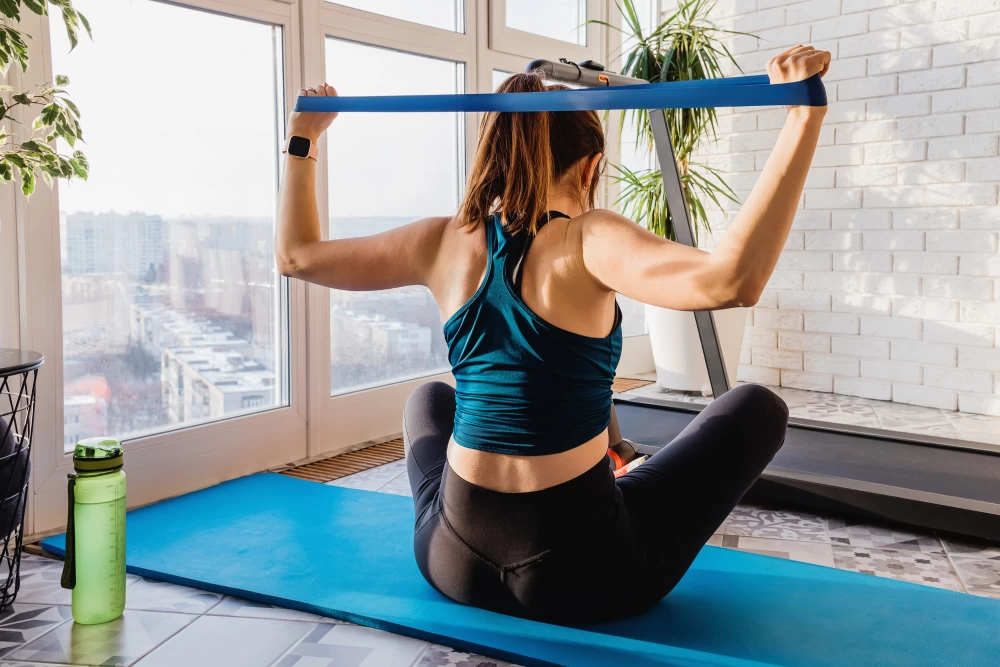
- 24th May 2023
Table of Contents
Gains from Resistance Band Exercises
Muscle gain and strength gains can be achieved quickly and efficiently through resistance band training. The portability of this form of exercise means that it can be done even when you don't have access to a gym or when you're away from home. You can train more frequently with resistance bands without incurring the same level of joint pain and fatigue as you would when using conventional weights. One of the best things about using resistance bands for exercise is how precisely you can target different muscle groups. To build muscle in your buttocks, for instance, you can do squats and lunges against a greater amount of resistance using a band made for that purpose. If you take a more targeted approach, you can see results more quickly and reduce the risk of injury. Finally, resistance bands can be used for a wide range of exercises, not just strength training. As an adjunct to physical therapy following an injury or operation, they can also be used for stretching exercises. Incorporating resistance band training into your fitness routine has many positive effects, including increased efficiency and decreased risk of injury.
Diverse Resistance Band Varieties
When used properly, resistance bands can be an effective tool for working out your entire body. The variety of sizes, densities, and forms available makes them suitable for a wide range of exercises. This article will explore the various resistance band options available. To begin, loop resistance bands are the most widely used variety. Squats, lunges, and leg raises are just some of the exercises that can benefit from these, and they come in a wide range of sizes and tensions. Second, people recovering from surgery or injury can use therapy or rehabilitation resistance bands. Thirdly, because they are more stable than loop bands, figure-eight resistance bands are great for upper body workouts like bicep curls and tricep extensions. In conclusion, understanding the various resistance band options will allow you to pick the band that is best suited to your fitness objectives. When shopping for an exercise band, keep in mind that the level of tension will dictate the difficulty of your routine.

Zones of Muscle Focus
Working out with a resistance band has exploded in popularity in recent years, and for good reason. These multipurpose tools allow you to work out multiple muscle groups with a single device. You can work a wide variety of upper-body, lower-body, and core muscles by strategically placing and moving the band. The glutes are a popular area to focus on when using resistance bands. You can really feel the burn in your glute muscles when you perform exercises like squats and lateral walks while wearing an exercise band around your thighs or ankles. The muscles in the back are another area of emphasis. Using a resistance band, you can perform effective upper back exercises like rows and pull-aparts. Resistance bands can be used to strengthen not only these larger muscle groups, but also smaller stabilising muscles in the shoulders and hips. These smaller muscles have to work harder to support your movements because resistance band exercises demand more balance and control than traditional weight lifting. In conclusion, resistance bands provide a variety of exercises that can be tailored to specific muscle groups, increasing the intensity and variety of your workouts.
Beginning-Level Workouts
One of the best ways to start strength training is with resistance band training. It has a small footprint, doesn't cost much, and can be done anywhere. Banded squats are one of the best resistance band exercises for beginners. This balance-enhancing exercise also strengthens your glutes, quads, and hamstrings. Banded push-ups are another excellent first-time workout option. Performing a resistance band push-up is as easy as wrapping the band around your back and holding onto it with your hands. The increased challenge will strengthen you from the ground up while also helping you tone your upper body. Finally, if you want to strengthen your upper back, try doing banded pull-aparts. Extend your arms until they are parallel to the ground, resistance band in front of you. Bring your shoulder blades back in towards each other and gently squeeze them together. If you suffer from poor posture or upper back pain due to prolonged desk work, try this exercise.
Extreme Exercises

Using resistance bands to exercise is a great way to increase the intensity of your routine. These bands can be used for anything from bicep curls to squats, and everything in between. Resistance band training is great for more advanced workouts because it allows you to focus on specific muscle groups. Resistance band workouts benefit greatly from routinely mixing up the exercises you perform with the bands. You can ease into more difficult exercises like burpees and jump squats from a foundation of easy stretches. Adding resistance band training to your high-intensity interval training (HIIT) routine is a great way to get in some cardiovascular exercise. Strength, flexibility, and endurance can all be enhanced by using resistance bands as part of an advanced workout routine. All you need is a set of resistance bands and some open floor space to perform this type of training, making it ideal for use both at home and on the go. Resistance band training is a great way to get in shape for the summer, whether your goal is to bulk up or tone up.
Advice for Your Protection
It is crucial to put security first when working out with resistance bands. One of the first things you should do is inspect your tools for damage. Using a band that has seen better days can increase the risk of an incident. When working out, you should also make sure you have plenty of room to move around without colliding with anything or anyone. Using correct form and technique when working out with resistance bands is another important safety tip. It's easy to lose control and get carried away, putting unnecessary stress on your muscles and joints. When using resistance bands, always begin with a lower tension and increase it gradually as your strength increases. Finally, before beginning a resistance band workout, be sure to warm up. Doing so will reduce the risk of muscle strains and injuries. Similarly, cooling down after exercise can help lessen muscle fatigue and prevent injuries. Stay safe while using resistance bands to get in shape by following these guidelines.
Resistance Bands Can Be Used For Many Different Exercises
In conclusion, resistance bands are an excellent tool for anyone hoping to increase their strength and general level of physical fitness. They are convenient for those who don't have access to a gym or who would rather exercise in the comfort of their own homes because of their ease of use, portability, and versatility. They also feature varying degrees of resistance, so that users can ramp up the difficulty of their exercises as they become more proficient. Training with a resistance band allows one to precisely target muscle groups while also improving overall stability and balance. The reason for this is that when performing resistance band exercises, the core muscles must be actively engaged at all times. Resistance bands are a great way to get a great workout without putting too much strain on your muscles, ligaments, and joints. If you're looking to spice up your workouts without breaking the bank, invest in some resistance bands. It's easy to see why these adaptable tools are gaining in popularity among health-conscious people around the world. If you want to improve your fitness in a way that is both effective and challenging, try using a resistance band during your next workout.
